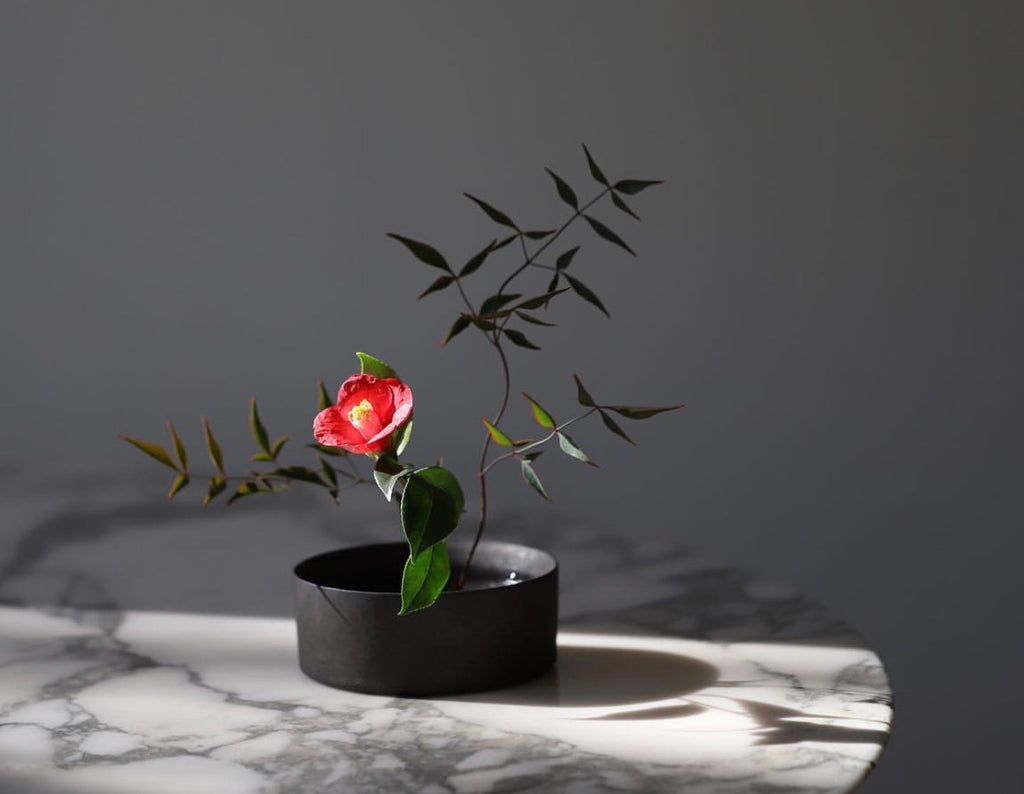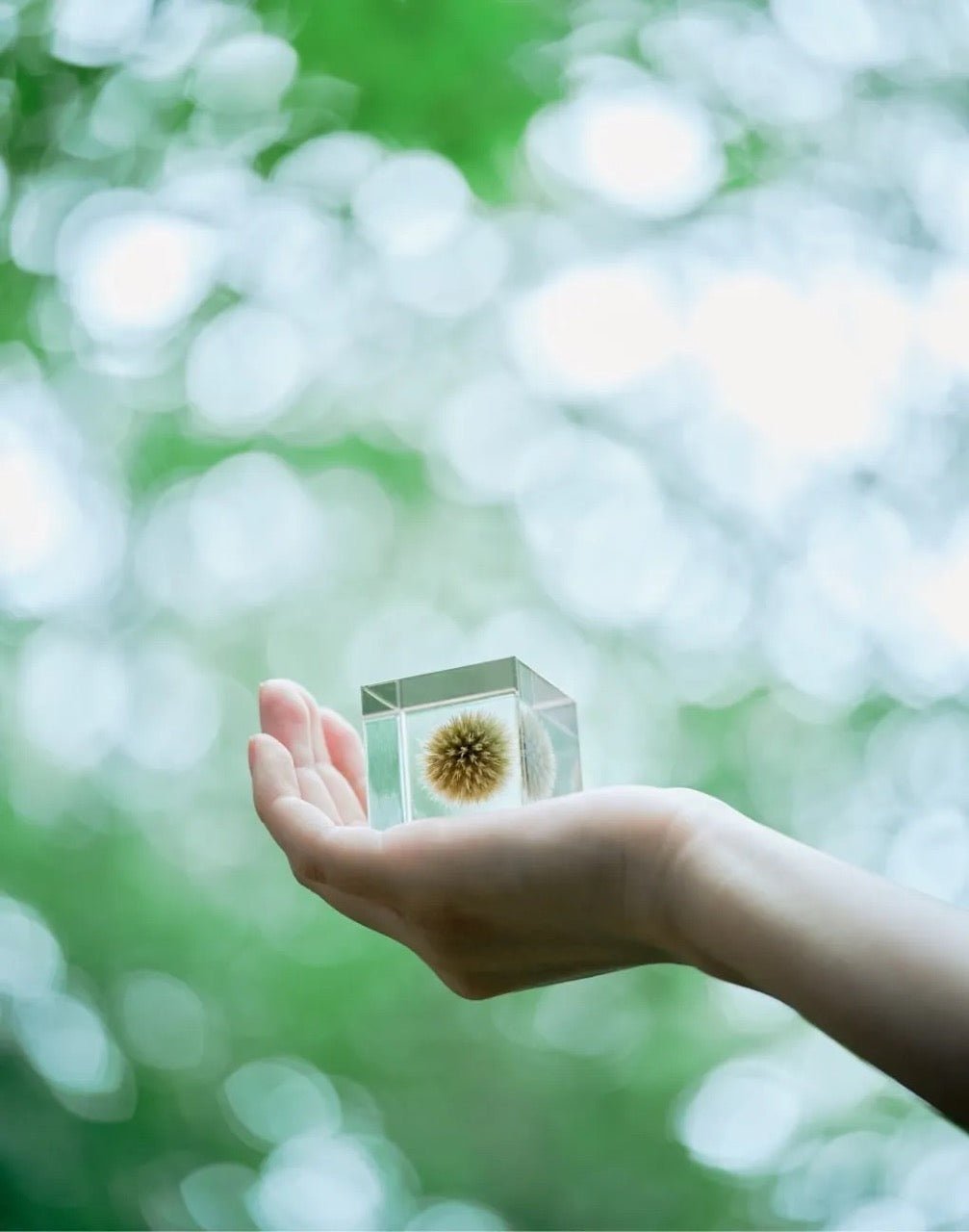
Naoko Zaima - Interview:

ET: Naoko, we're so excited to be in your good company this month. What will you be sharing with us during your intimate ikebana lecture at Tortoise?
NZ: I teach Sogetsu ikebana, beginner to advanced levels. Ikebana is lifetime learning so at my lecture, I will only teach the very basics. I will show you how to use kenzans, how to cut the stems and branches, how to insert them into the base, and I’ll show you ways to make the most basic styles of ikebana. It’s a demonstration that’s perfect for beginners.

ET: You're a regular visitor of Tortoise, and I recognize many of the vessels in your arrangements. Are you able to find what you need at Tortoise for your ikebana practice?
NZ: I love Tortoise, I have stopped by many times to find vases. It’s hard to find ikebana vases in the U.S., so I’m lucky to have Tortoise nearby. I’ll find Hasami Porcelain of course, but also baskets, sometimes vintage vases.

ET: How do you choose a vessel for an arrangement? Do you choose the vessel for the flowers or the flowers for the vessel when you start?
NZ: Both. I will pick the vases first, then sometimes, I’ll pick the flowers first. Hasami Porcelain gives me good inspiration, which is why I love using it. The shape is perfect, firstly. The color and texture is different from other vases. In ikebana, we are taught to use round and shallow shaped vessels most often. But most of these containers are not so nice: traditional, old fashioned and a bit lame [laughs]. But when I found Hasami, I thought this is it–very modern and sophisticated. It’s why I fell in love with Hasami Porcelain. You have different sizes and shapes, and by combining them, I can even create unique vessels.

ET: Yes, I saw you stacking Hasami Porcelain as a vase! Very sculptural. When did you start Ikebana?
NZ: I started ikebana 10 years ago. I was introduced by my teacher who was a Sogetsu teacher. Her creations were modern and a bit Western in style, but always mixed with Japanese sensibility.

ET: Can you explain your perspective on the difference between Western and Japanese style of arranging?
NZ: In ikebana each stem is important. Each stem has meaning. You’re tasked to find the most beautiful line of each material, and then we arrange them one by one. In the western way of arranging, you bunch flowers together for a dramatic arrangement. But in ikebana, just a few materials can make a dramatic arrangement. I will typically use just 3 or 4 stems to create a poetic arrangement. That’s why I love ikebana, because you don’t need many flowers–it’s very economical. And even when they dry out, the flowers are still beautiful. They’re not as fresh and gorgeous when they start out, but I love their natural beauty when they dry out, and I love how ikebana can express that natural beauty.

ET: As someone who has never done ikebana before, I'm surprised by how moving it can be visually. Tulips are one of my favorite flowers. And I saw an arrangement you made with two tulips. One is reaching up and another swoops down. I stared at that arrangement for a while because ikebana had transformed my favorite flower into something brand new–it was exciting. Why does ikebana feel so dramatic?
NZ: Before starting an arrangement, you have to observe your materials one by one carefully to find their most beautiful angles and lines. I tell my students to dialogue with the flowers and find out what they want, what they want to show. You can feel this when you face them and have a conversation with them. And then little by little, you’ll master the best way to use flowers. Especially branches, they all have their best angle and lines–and you want to show that. Materials come first. That’s why one line can make a poetic expression. Like a person, each person has their own beauty. You don’t have to be tall or model skinny, each person has their own unique fascination that makes them beautiful–flowers are the same.

ET: In ikebana, are you looking for the prettiest flower? The greenest leaf?
NZ: I can make an arrangement with any flower. Even if I have only one or two flowers, I can make an ikebana. During the pandemic, all flower markets were closed, and I couldn’t find flowers anywhere. So materials were scarce, but I learned that I could make several arrangements with just a few materials by changing the line a little bit, changing their shape a little bit and creating something poetic and new. That’s what I like about ikebana.

ET: Are you making arrangements everyday?
NZ: If I have time, then yes everyday. Almost everyday.

ET: Do you already have an idea in your mind of what your arrangement is going to look like before you start?
NZ: No. During my process, I am receiving inspiration–so it all depends on my arrangement. I get inspiration from the flowers and vessels. I don’t decide anything beforehand. I don’t have any goals, everything is free and the inspiration comes to me.

ET: Is there such a thing as a casual ikebana arranger, or casual ikebana arranging? Can anyone do it?
NZ: Yes, of course. You only need a small vase, a small kenzan, and just a few materials to start casually. Just change the length of stems and create a rhythm, it’s easy. You don’t have to use your favorite flower–you can use any flower.

ET: When flower arranging, how does it feel? And how long do you keep an arrangement for after you make it? Flowers don't stay fresh forever, but do you keep your arrangements?
NZ: I feel like I’m meditating. I’m so into it. I’m focused, and it’s very comfortable for me. I’m always trying to get into my creation. After I create an arrangement, normally I break it down and make the next one. I want to create a couple arrangements while the material is fresh.

ET: When you're arranging, you're choosing flowers that are in season naturally, but are you ever trying to express larger emotional concepts when you're arranging?
NZ: It depends on the branches. Spring time has cherry blossoms, peach flowers, and a lot of bright flowered branches, so I can make a very happy arrangement. So many good branches come in spring time. Then in autumn, there’s just a few branches–like bittersweet branches, and stark branches that look a bit lonely and darker. Ikebana depends a lot on branches for me, not flowers.

ET: Do you ever create an arrangement you’re not totally fond of?
NZ: A lot. It’s not always a 100% success.

ET: Having done ikebana so long and now publishing this book, do you think ikebana teaches more than just flower arranging?
NZ: Definitely. Learning ikebana teaches calmness, how to be centered. Ikebana teaches you how to express yourself by creating something and having an output. By creating ikebana, you’ll connect to your inner self; you’ll understand yourself better; then you’ll love yourself better I think. Kado means the way of flowers, are you familiar with this term? Chado, for example, is the way of tea, kado is the way of flowers. The 'way of something' is an important cultural touchstone in Japan–it takes a lifetime to master the way of something. The way of something, the “do” is teaching you not just technique but teaching you the mindset and heart behind the techniques. The way of doing something is always grounded in respect–respect for people, respect for friends, respect for surroundings, respect for materials–it’s your manners. It becomes your lifestyle beyond arranging flowers too, it’s a manner and respect you possess and carry with you always. Chado, kendo, judo, kodo, these all include the mindset. Kado is respect for nature, respect for people, respect for the Earth. We want to respect the flowers, that’s why we don’t want to use many flowers. That’s why we love buds and we love flowers even when they dry up. Every time I throw away material, I tell them thank you. I show them politeness. When I teach ikebana, I will teach my students kado as well–but only little by little, because if I share too much at once, they’ll panic [laughs].

***
We’re welcoming back Good Company with our eighth installment featuring ikebana artist and instructor Naoko Zaima. Naoko is a certified Sogetsu ikebana instructor and a newly published author of Inspired Ikebana: Modern Design Meets the Ancient Art of Japanese Flower Arrangement. We'll be hosting Naoko on Sunday, March 12th with a special lecture on ikebana flower arrangement from 10 AM to 11 AM followed by a book-signing and meet & greet with Naoko from 12 PM to 5 PM. For fans of Naoko's work, we'll be showcasing her striking ikebana in HASAMI PORCELAIN vessels at Tortoise starting Saturday, March 11th, and they'll be available for purchase over the weekend for our in-store guests. You'll be able to take home the entire arrangement including the HASAMI PORCELAIN vessel, the kenzan tool and the flowers–all hand-selected and arranged by Naoko. We hope you join us next week! Jump below to learn more about Naoko and her practice.



